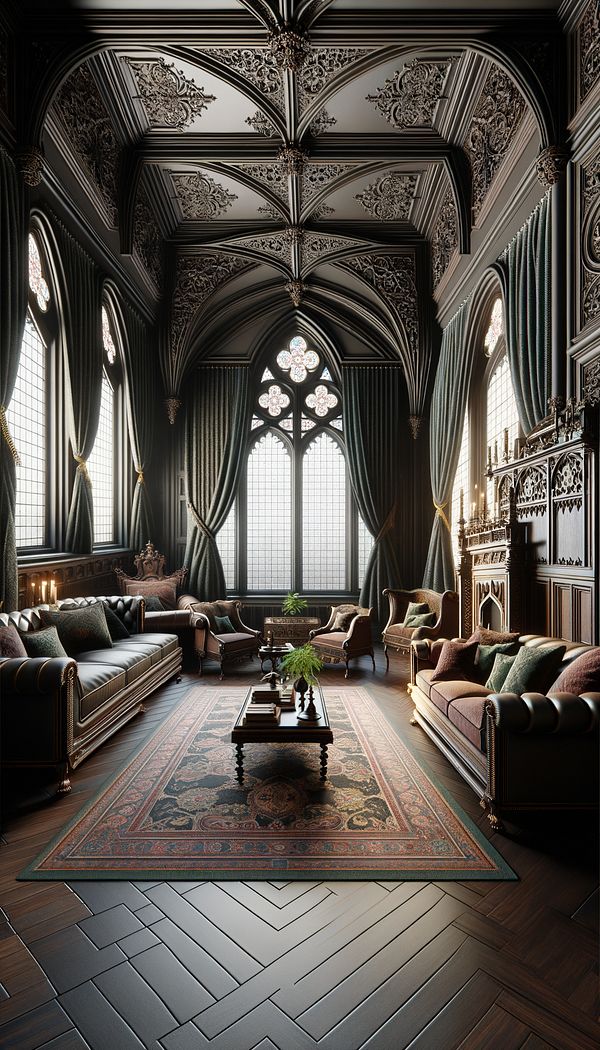What is Gothic Revival?
Gothic Revival is a design style that reinterprets the architecture, interiors, and decorative arts of the Gothic period.
Description
Gothic Revival, also known as Victorian Gothic or Neo-Gothic, is a design style that emerged in the late 18th century and gained prominence in the 19th century. This movement sought to revive the architectural and decorative styles of the Gothic period, which spanned from the 12th to the 16th centuries. Characterized by pointed arches, ribbed vaults, and flying buttresses, Gothic Revival emphasizes verticality, intricate detail, and the use of symbolic motifs.
In interior design, Gothic Revival incorporates these architectural elements into furniture, lighting, and textiles, incorporating rich colors and patterns that reflect the complexity and opulence of the period. It often involves the use of dark woods, ornate carvings, and ecclesiastical-inspired motifs. The style is notable for its dramatic and romantic aesthetic, making it a popular choice for those looking to make a bold statement in their interiors.
The revival of the Gothic aesthetic was driven, in part, by a growing appreciation for the craftsmanship and artistic quality of medieval design. It aligned with the Victorian era's fascination with history, spirituality, and the exotic. While primarily seen in architecture, the style also significantly influenced furniture design, decorative arts, and even landscaping.
Usage
Examples of Gothic Revival in practice include the elaborate decorative schemes of historic churches and cathedrals repurposed for modern use, grandiosely styled private residences with pointed arch windows and ornate wooden furnishings, and stylishly themed restaurants or bars that capitalize on the romantic and mysterious ambiance of the Gothic period.
FAQs
-
What are the key features of Gothic Revival interior design?
Key features include pointed arches, intricate detailing, the use of dark woods and rich fabrics, ornate carvings, and ecclesiastical-inspired motifs. The style emphasizes a dramatic and romantic atmosphere through its complex decorative elements.
-
How does Gothic Revival differ from original Gothic design?
Gothic Revival is a reinterpretation rather than a direct continuation of original Gothic design. It focuses on the aesthetic and decorative aspects of Gothic architecture and design, often incorporating these elements into modern settings with a romantic or nostalgic flair.
-
Where is Gothic Revival most commonly seen?
Gothic Revival is most commonly seen in architecture, notably in churches, cathedrals, universities, and private residences. However, its influence also extends to interior design, furniture, decorative arts, and landscaping in both public and private spaces.
Practical Application
To incorporate Gothic Revival elements into a space, consider adding pointed arch details, stained glass, elaborate wood carvings, or textiles featuring rich, medieval-inspired patterns. Furniture pieces such as high-backed chairs and ornate tables also help achieve this look. Blending these elements with modern comforts can create an eclectic and dramatic interior that pays homage to the historic Gothic aesthetic.
-
Architectural Elements199 articles
-
Design Styles478 articles
-
Furniture Types599 articles
-
Lighting111 articles
-
Decorative Techniques322 articles
-
IncandescentIncandescent refers to a type of lighting that produces light through the heating of a filament.
-
FrescoFresco is a technique of mural painting executed upon freshly laid wet plaster.
-
French Country StyleFrench Country Style is an elegant and rustic design approach, inspired by the homes in the French countryside.
-
EastlakeEastlake is a design movement named after Charles Eastlake.
-
SoftwoodSoftwood is wood derived from coniferous trees.
